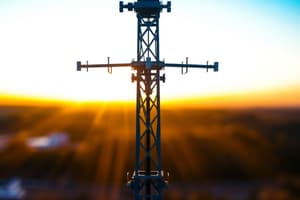Podcast
Questions and Answers
Explain the use of loop antenna in radio direction finding.
Explain the use of loop antenna in radio direction finding.
A loop antenna is used in radio direction finding to determine the direction of a radio signal source by detecting the phase difference between the signals received by the loop's two arms.
Derive an expression for the array factor of an N element linear array where all elements are equally fed and spaced. Also, find the expression for the position of principal maxima, null, and secondary maxima.
Derive an expression for the array factor of an N element linear array where all elements are equally fed and spaced. Also, find the expression for the position of principal maxima, null, and secondary maxima.
The array factor for an N element linear array is $AF(\theta) = Nsin(\frac{N\pi d}{\lambda}sin(\theta))$. The principal maxima occur at $\theta = 0$, the nulls at $\theta = \pm \frac{m\pi}{N}$, and the secondary maxima at $\theta = \pm \frac{2m+1}{2N}\pi$.
Drive an expression for the array factor of two isotropic sources with the same amplitude and in opposite phase. Find its HPBW and BWFN.
Drive an expression for the array factor of two isotropic sources with the same amplitude and in opposite phase. Find its HPBW and BWFN.
The array factor for two isotropic sources with the same amplitude and opposite phase is $AF( heta) = 2 + 2cos(\theta)$. The Half Power Beamwidth (HPBW) is 180 degrees and the Backward Front-to-Back Ratio (BWFN) is 0 dB.
Explain what a folded antenna is, draw its typical structure, explain its working mechanism, and state its advantages.
Explain what a folded antenna is, draw its typical structure, explain its working mechanism, and state its advantages.
Compare broadside and End fire array.
Compare broadside and End fire array.
Derive the radiation resistance of a small dipole and explain its significance.
Derive the radiation resistance of a small dipole and explain its significance.
Derive the expression for the radiation resistance of a half-wavelength dipole antenna. Why does the actual length of a half-wavelength dipole antenna lie between 0.47λ to 0.48λ instead of 0.5λ?
Derive the expression for the radiation resistance of a half-wavelength dipole antenna. Why does the actual length of a half-wavelength dipole antenna lie between 0.47λ to 0.48λ instead of 0.5λ?
Flashcards are hidden until you start studying




